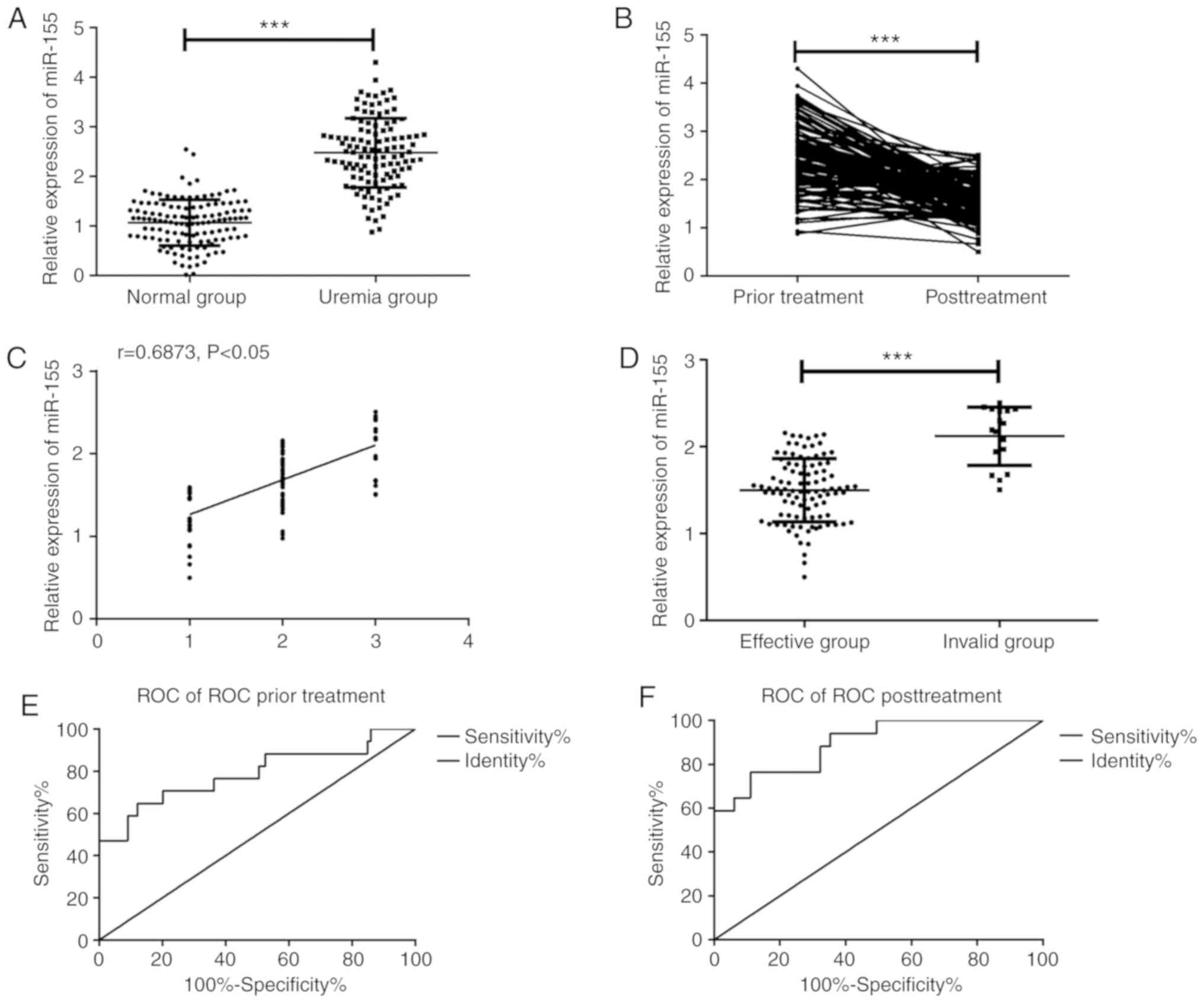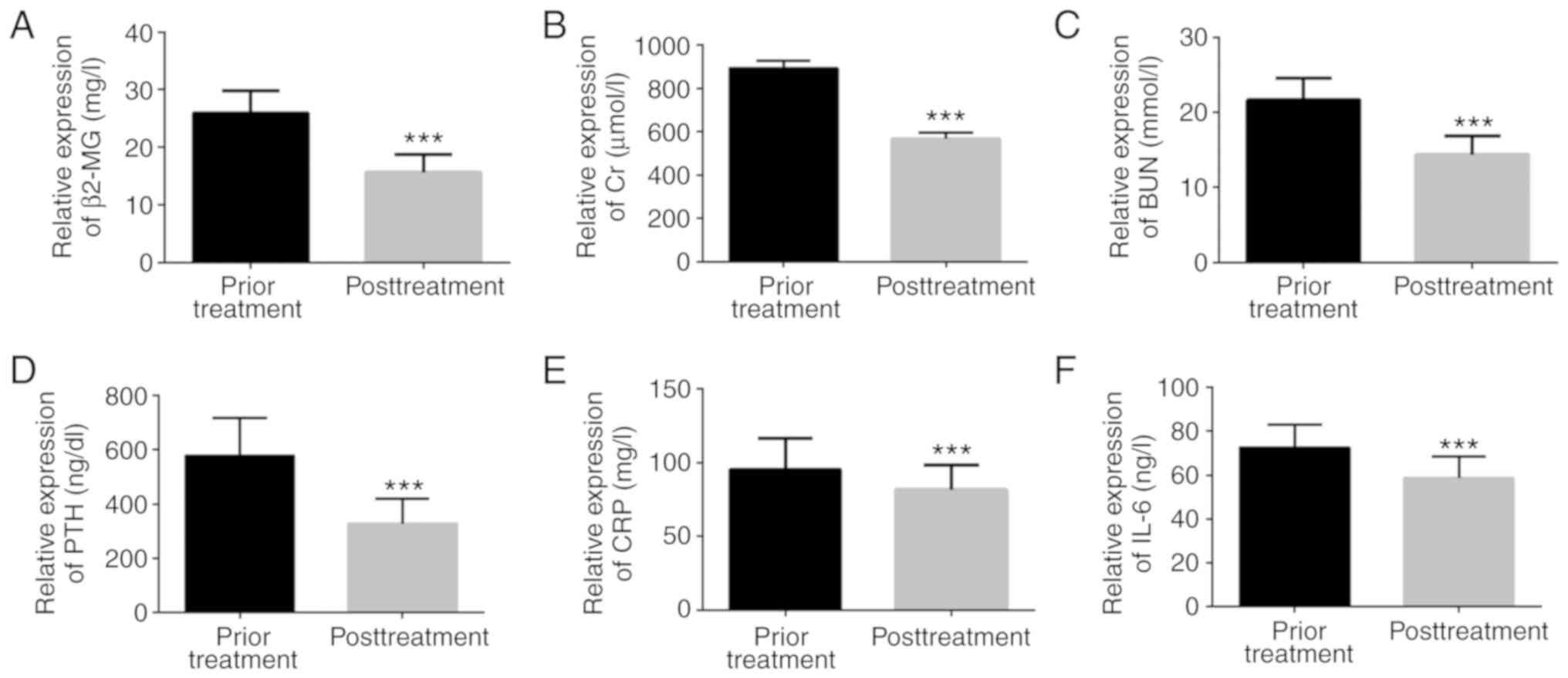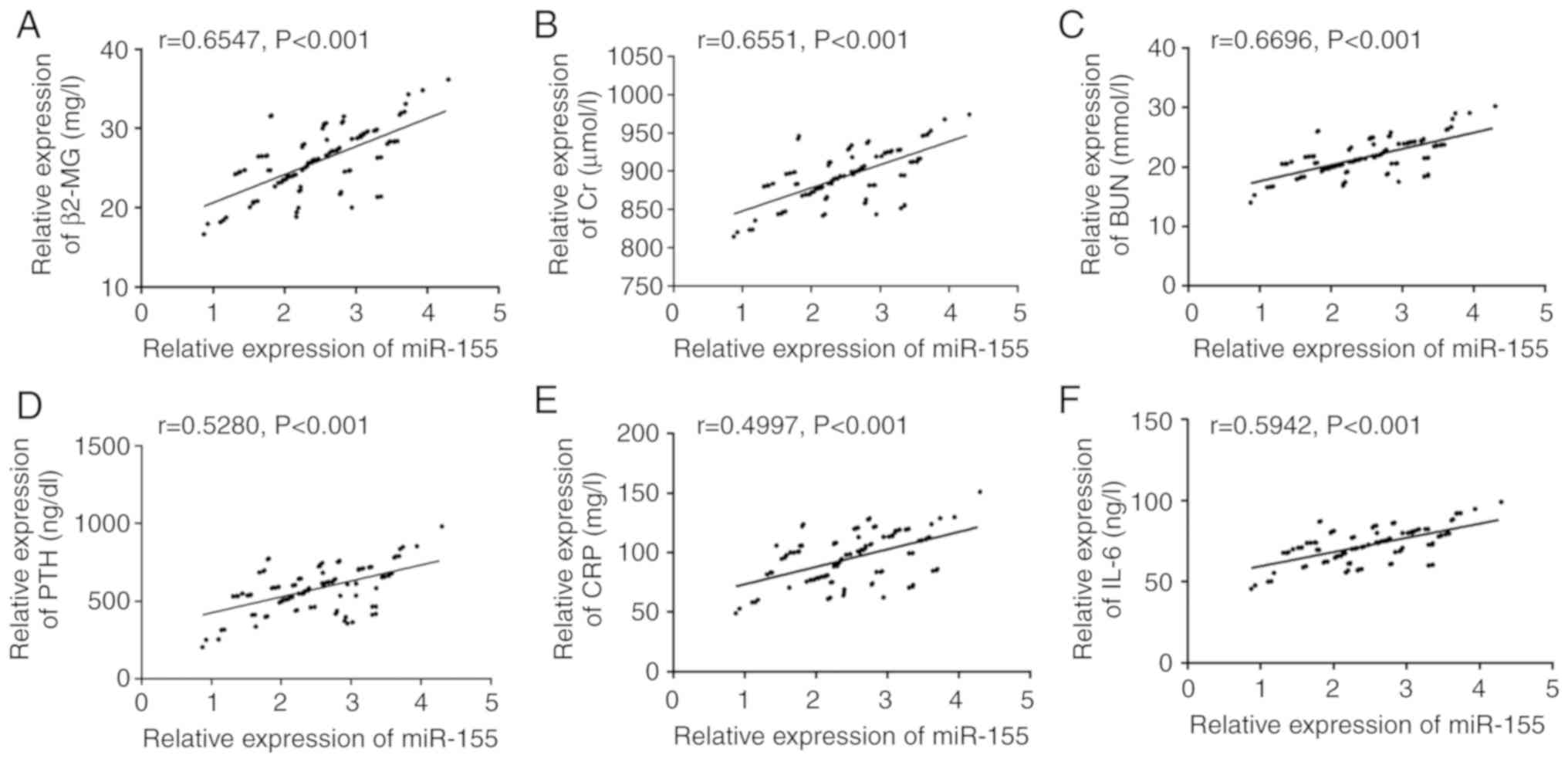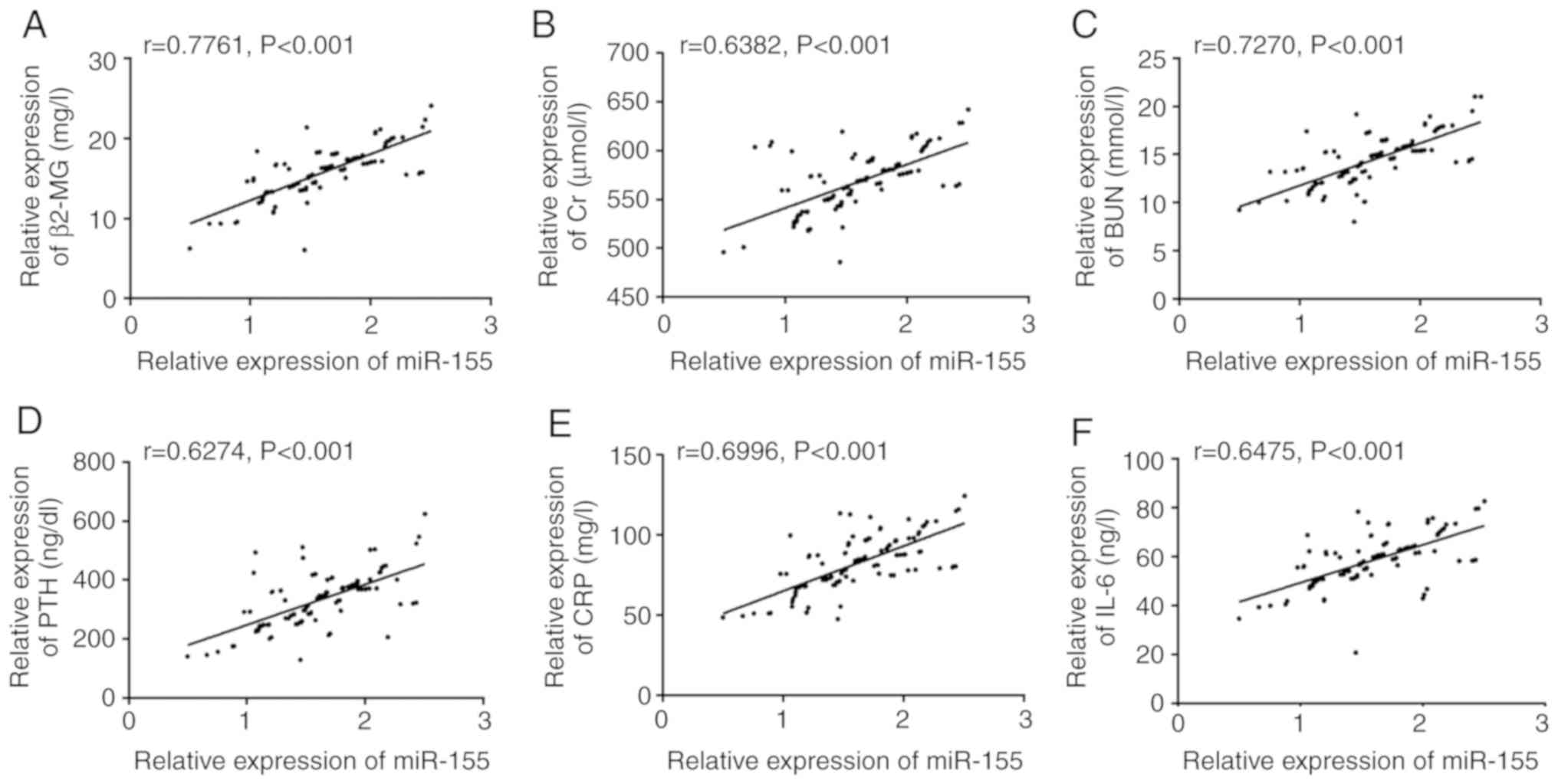|
1
|
Scherer A, Günther OP, Balshaw RF,
Hollander Z, Wilson-McManus J, Ng R, McMaster WR, McManus BM and
Keown PA: Alteration of human blood cell transcriptome in uremia.
BMC Med Genomics. 6(23)2013.PubMed/NCBI View Article : Google Scholar
|
|
2
|
Chapagain A, Caton PW, Kieswich J,
Andrikopoulos P, Nayuni N, Long JH, Harwood SM, Webster SP, Raftery
MJ, Thiemermann C, et al: Elevated hepatic 11β-hydroxysteroid
dehydrogenase type 1 induces insulin resistance in uremia. Proc
Natl Acad Sci USA. 111:3817–3822. 2014.PubMed/NCBI View Article : Google Scholar
|
|
3
|
Shang W, Shen Y, Gao S, Feng G, Feng Y,
Wang Z and Zhang X: Comparison of HLA-A, -B and -DRB1 loci
polymorphism between kidney transplants of uremia patients and
healthy individuals in Central China. PLoS One.
11(e0165426)2016.PubMed/NCBI View Article : Google Scholar
|
|
4
|
Vitetta L and Gobe G: Uremia and chronic
kidney disease: The role of the gut microflora and therapies with
pro- and prebiotics. Mol Nutr Food Res. 57:824–832. 2013.PubMed/NCBI View Article : Google Scholar
|
|
5
|
Lu W and Jiang GR: HD/HP versus HD trial
Group. Randomised, open-label, multicentre trial comparing
haemodialysis plus haemoperfusion versus haemodialysis alone in
adult patients with end-stage renal disease (HD/HP vs. HD): Study
protocol. BMJ Open. 8(e022169)2018.PubMed/NCBI View Article : Google Scholar
|
|
6
|
Li J, Li D, Xu Y, Wang A, Xu C and Yu C:
The optimal timing of hemoperfusion component in combined
hemodialysis-hemoperfusion treatment for uremic toxins removal. Ren
Fail. 37:103–107. 2015.PubMed/NCBI View Article : Google Scholar
|
|
7
|
Li Z, Wang G, Zhen G, Zhang Y, Liu J and
Liu S: Effects of hemodialysis combined with hemoperfusion on
severe acute pancreatitis. Turk J Gastroenterol. 29:198–202.
2018.PubMed/NCBI View Article : Google Scholar
|
|
8
|
Wang YT, Fu JJ, Li XL, Li YR, Li CF and
Zhou CY: Effects of hemodialysis and hemoperfusion on inflammatory
factors and nuclear transcription factors in peripheral blood cell
of multiple organ dysfunction syndrome. Eur Rev Med Pharmacol Sci.
20:745–750. 2016.PubMed/NCBI
|
|
9
|
Xu X, Yu Z, Liang Y, Gao H, Liu Y and Yu
Y: Mumps caused by paraquat-induced poisoning: A case report. Exp
Ther Med. 13:401–404. 2017.PubMed/NCBI View Article : Google Scholar
|
|
10
|
Li MQ, Shi ZX, Xu JY, Lu B, Li JQ, Xu YJ,
Wang XM, Li SM and Mo X: Hemodiafiltration combined with
resin-mediated absorption as a therapy for hyperlipidemic acute
pancreatitis. Cell Biochem Biophys. 69:699–702. 2014.PubMed/NCBI View Article : Google Scholar
|
|
11
|
Wang GK, Zhu JQ, Zhang JT, Li Q, Li Y, He
J, Qin YW and Jing Q: Circulating microRNA: A novel potential
biomarker for early diagnosis of acute myocardial infarction in
humans. Eur Heart J. 31:659–666. 2010.PubMed/NCBI View Article : Google Scholar
|
|
12
|
Mukhadi S, Hull R, Mbita Z and Dlamini Z:
The role of microRNAs in kidney disease. Noncoding RNA. 1:192–221.
2015.PubMed/NCBI View Article : Google Scholar
|
|
13
|
Ji H, Tian D, Zhang B, Zhang Y, Yan D and
Wu S: Overexpression of miR-155 in clear-cell renal cell carcinoma
and its oncogenic effect through targeting FOXO3a. Exp Ther Med.
13:2286–2292. 2017.PubMed/NCBI View Article : Google Scholar
|
|
14
|
Blaya D, Aguilar-Bravo B, Hao F,
Casacuberta-Serra S, Coll M, Perea L, Vallverdú J, Graupera I, Pose
E, Llovet L, et al: Expression of microRNA-155 in inflammatory
cells modulates liver injury. Hepatology. 68:691–706.
2018.PubMed/NCBI View Article : Google Scholar
|
|
15
|
Zhang W, Shi L, Zhang H, Wang C, Gao S, Ma
Y, Li W and Liu J, Wang J and Liu J: Effect of alprostadil on serum
level of miRNA-155 in uremic patients. Zhong Nan Da Xue Xue Bao Yi
Xue Ban. 40:735–741. 2015.PubMed/NCBI View Article : Google Scholar : (In Chinese).
|
|
16
|
Livak KJ and Schmittgen TD: Analysis of
relative gene expression data using real-time quantitative PCR and
the 2(-Delta Delta C(T)) method. Methods. 25:402–408.
2001.PubMed/NCBI View Article : Google Scholar
|
|
17
|
Cai W, Chen WL and Fu HL: Effect of
Muxiang shunqi pill on digestive disorders of prephase uremia
patients and its mechanism. Zhongguo Zhong Xi Yi Jie He Za Zhi.
37:34–38. 2017.PubMed/NCBI(In Chinese).
|
|
18
|
Xue W, Zhao Y, Yuan M and Zhao Z: Chinese
herbal bath therapy for the treatment of uremic pruritus:
Meta-analysis of randomized controlled trials. BMC Complement
Altern Med. 19(103)2019.PubMed/NCBI View Article : Google Scholar
|
|
19
|
Lisowska-Myjak B: Uremic toxins and their
effects on multiple organ systems. Nephron Clin Pract. 128:303–311.
2014.PubMed/NCBI View Article : Google Scholar
|
|
20
|
Li G, Ma H, Yin Y and Wang J: CRP, IL-2
and TNF-α level in patients with uremia receiving hemodialysis. Mol
Med Rep. 17:3350–3355. 2018.PubMed/NCBI View Article : Google Scholar
|
|
21
|
Zhang J, Yuan Y, An X, Ouyang C, Ren H,
Yang G, Yu X, Lv X, Zhang B, Wang N, et al: Comparison of combined
blood purification techniques in treatment of dialysis patients
with uraemic pruritus. Int J Clin Exp Med. 9:8563–8568. 2016.
|
|
22
|
Belarbia A, Nouira S, Sahtout W, Guedri Y
and Achour A: Metabolic syndrome and chronic kidney disease. Saudi
J Kidney Dis Transpl. 26:931–940. 2015.PubMed/NCBI View Article : Google Scholar
|
|
23
|
Gao Y, Ma X, Yao Y, Li H, Fan Y, Zhang Y,
Zhao C, Wang L, Ma M, Lei Z and Zhang X: miR-155 regulates the
proliferation and invasion of clear cell renal cell carcinoma cells
by targeting E2F2. Oncotarget. 7:20324–30337. 2016.PubMed/NCBI View Article : Google Scholar
|
|
24
|
Kurowska-Stolarska M, Alivernini S,
Ballantine LE, Asquith DL, Millar NL, Gilchrist DS, Reilly J, Ierna
M, Fraser AR, Stolarski B, et al: MicroRNA-155 as a proinflammatory
regulator in clinical and experimental arthritis. Proc Natl Acad
Sci USA. 108:11193–11198. 2011.PubMed/NCBI View Article : Google Scholar
|
|
25
|
Ulivi P, Canale M, Passardi A, Marisi G,
Valgiusti M, Frassineti GL, Calistri D, Amadori D and Scarpi E:
Circulating plasma levels of miR-20b, miR-29b and miR-155 as
predictors of bevacizumab efficacy in patients with metastatic
colorectal cancer. Int J Mol Sci. 19(307)2018.PubMed/NCBI View Article : Google Scholar
|
|
26
|
Liang S, Cai GY, Duan ZY, Liu SW, Wu J, Lv
Y, Hou K, Li ZX, Zhang XG and Chen XM: Urinary sediment miRNAs
reflect tubulointerstitial damage and therapeutic response in IgA
nephropathy. BMC Nephrol. 18(63)2017.PubMed/NCBI View Article : Google Scholar
|
|
27
|
Marcucci G, Maharry KS, Metzeler KH,
Volinia S, Wu YZ, Mrózek K, Nicolet D, Kohlschmidt J, Whitman SP,
Mendler JH, et al: Clinical role of microRNAs in cytogenetically
normal acute myeloid leukemia: miR-155 upregulation independently
identifies high-risk patients. J Clin Oncol. 31:2086–2093.
2013.PubMed/NCBI View Article : Google Scholar
|
|
28
|
Dung NH, Kien NT, Hai NTT, Cuong PT, Huong
NTT, Quyen DBQ, Tuan NM, Ha DM, Kien TQ, Dung NTT, et al: Measuring
serum beta2-microglobulin to predict long-term mortality in
hemodialysis patients using low-flux dialyzer reuse. Ther Clin Risk
Manag. 15:839–846. 2019.PubMed/NCBI View Article : Google Scholar
|
|
29
|
Chen L, Fan D and Shi X: Comparison of the
effects of different blood purification methods on removal of
macromolecules in uremia. Chin J Primar Med Pharm. 24:1445–1449.
2017.(In Chinese).
|
|
30
|
Levine BS, Rodríguez M and Felsenfeld AJ:
Serum calcium and bone: Effect of PTH, phosphate, vitamin D and
uremia. Nefrologia. 34:658–669. 2014.PubMed/NCBI View Article : Google Scholar : (In English,
Spanish).
|
|
31
|
Gao P, Ma JR, Zhao L, Pei GC, Shi GJ and
Li L: Effect of high-flux and low-flux hemodialysis on the side
metabolites and cytokines in patients with uremia. J Hainan Med
Univ. 23:61–64. 2017.
|
|
32
|
Chen Y, Duan J, Guo J, Shang E, Tang Y,
Qian Y, Tao W and Liu P: Yuanhuapine-induced intestinal and
hepatotoxicity were correlated with disturbance of amino acids,
lipids, carbohydrate metabolism and gut microflora function: A rat
urine metabonomic study. J Chromatogr B Analyt Technol Biomed Life
Sci. 1026:183–192. 2016.PubMed/NCBI View Article : Google Scholar
|
|
33
|
Carrero JJ and Stenvinkel P: Inflammation
in end-stage renal disease-what have we learned in 10 years? Semin
Dial. 23:498–509. 2010.PubMed/NCBI View Article : Google Scholar
|
|
34
|
Zhou H, Zhou D, Lu J, Wu C and Zhu Z:
Effects of pre-cardiopulmonary bypass administration of
dexmedetomidine on cardiac injuries and the inflammatory response
in valve replacement surgery with a sevoflurane postconditioning
protocol: A pilot study. J Cardiovasc Pharmacol. 74:91–97.
2019.PubMed/NCBI View Article : Google Scholar
|
|
35
|
Shao QY, Wan C, Liu J and Zhang M: Effect
of peritoneal dialysis on inflammatory factors, nutritional index
and renal function in patients with chronic renal failure. J Hainan
Med Univ. 23:87–90. 2017.
|
|
36
|
Xiangming LI, Zhang W and Shen D: The
effect of hemodialysis filtration combined with blood perfusion in
the treatment of patients with uremic encephalopathy. Chin J
Primary Med Pharm. 23:457–459. 2016.
|
|
37
|
Wang LY, Yin DX, Zhang DL, Xu R, Cui WY
and Liu WH: Improvement and influencing factors of blood pressure
control by nephrologist referral in chronic kidney disease patients
in China: A cohort study. Int Urol Nephrol. 45:1345–1353.
2013.PubMed/NCBI View Article : Google Scholar
|
|
38
|
Wang Y, Li J, Tong L, Zhang J, Zhai A, Xu
K, Wei L and Chu M: The prognostic value of miR-21 and miR-155 in
non-small-cell lung cancer: A meta-analysis. Jpn J Clin Oncol.
43:813–820. 2013.PubMed/NCBI View Article : Google Scholar
|


















